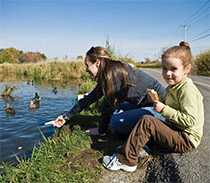NCEH State Fact Sheets: Louisiana
CDC 24/7: Saving Lives. Protecting People from Health Threats. Saving Money through Prevention.
Environmental Health
 Your environment is everything around you—the air you breathe, the water you drink, the community around you, the places where your food is grown or prepared, your workplace, and your home. When your environment is safe and healthy, you are more likely to stay healthy. But when your environment exposes you to dangerous events or toxic substances, your health can be affected negatively.
Your environment is everything around you—the air you breathe, the water you drink, the community around you, the places where your food is grown or prepared, your workplace, and your home. When your environment is safe and healthy, you are more likely to stay healthy. But when your environment exposes you to dangerous events or toxic substances, your health can be affected negatively.
CDC is committed to saving lives and protecting people from environmental hazards by responding to natural and man-made disasters, supporting public health workers, educating communities, and providing scientific knowledge. We help maintain and improve the health of Americans by promoting a healthy environment and preventing premature death and avoidable illness caused by environmental and related factors. We also identify how people might be exposed to hazardous substances in the environment and assess exposures to determine if they are hazardous to human health. CDC invests in prevention to improve health and save money by reducing healthcare costs. We remain committed to maximizing the impact of every dollar entrusted to the agency.

Asthma
- Louisiana falls within the top 25% of states for asthma-related deaths.
- An estimated 360,000 adults and children in Louisiana currently have asthma.
- One in 10 Louisiana households with children has at least one child with asthma.
From: http://new.dhh.louisiana.gov/
index.cfm/page/596
and
http://www.cdc.gov/asthma/
contacts/factsheets/Asthma-Louisiana_final.pdf
Funded Activities
National Asthma Control Program
(FY 2013 funding for Louisiana—$286,000. A new funding announcement has been released; FY 2014 funding information will be available later in the year.)
Asthma is a common disease on the rise, with significant health disparities and associated healthcare costs. Nearly 1 in 12 Americans (26 million) have asthma. In the last decade, the proportion of people with asthma, grew by nearly 15%.
CDC has been working with states for more than 10 years to implement community-based interventions, build local coalitions, and track the impact of the disease on the U.S. population.
The program focuses on what works to control asthma: assessing and measuring changes in disease severity and control, using the right medications, educating people to manage their conditions, and controlling environmental irritants and allergens.
Even though the number of people with asthma has increased over the last 10 years, trends show that more are controlling their disease:
Lead Poisoning Prevention Program
(FY 2011 funding for Louisiana—$594,000; because of funding reductions, the program was discontinued in 2012. Some funding was restored in FY 2014. States will be recompeting for funding and more information will be available later in the year.)
More than 12 million U.S. children are exposed to lead in their homes at levels that can harm their intellectual development. No safe blood lead level in children has been identified.
Reducing children’s lead exposure is perhaps the greatest environmental health accomplishment in the past 20 years.
For more than 20 years, CDC has funded state and local health agencies to
- Support surveillance, training, and technical capacity to help identify children with dangerous exposures to lead.
- Connect these families and children to appropriate healthcare and case management.
- Inspect and remediate unsafe homes.
Children who are exposed to lead lose $3,000 to almost $8,000 in lifetime productivity for each 1 microgram per deciliter (μg/dL) increase in blood lead level. Blood lead levels over 1 μg/dL are associated with measurable reductions in IQ.
Between 2007–2008 and 2009–2010, interventions that control or eliminate lead hazards before children are exposed (primary prevention) helped reduce the number of children exposed to lead (blood lead levels ≥ 1μg/dL) by nearly 3 million, saving $26–57 billion in lifetime productivity earnings alone. These estimates do not account for behavioral and other adverse effects on lifetime productivity linked to lead.

Tracking
- Tracking data are available on a number of health indicators, including air quality, cancer, heart attacks, and developmental disabilities.
- Tracking data are also available on environmental indicators such as air, water, and climate change, as well as on exposure data such as levels of chemicals in a person’s blood or body fluids.
From: http://lepht.dhh.la.gov/Pages/
LA%20EPHT%20Program.aspx
Environmental Public Health Tracking Program
(FY 2013 funding for Louisiana—$441,000. A new funding announcement has been released; FY 2014 funding information will be available later in the year.)
The World Health Organization (WHO) estimates that nearly 25% of all diseases are caused by environmental exposures. Some of these diseases—such as cancer, asthma, and cardiovascular disease—are the greatest killers today.
CDC’s Environmental Public Health Tracking Network (a.k.a. Tracking Network) is a dynamic web-based tool that tracks and reports environmental hazards and the health problems that may be related to them.
The Tracking Network’s integrated health, environmental exposure, and hazard information is used to
Since 2005, the Tracking Network has led to at least 160 public health interventions that prevent or control potential health effects from environmental exposures.
Safe Water Program
(FY 2013 funding for Louisiana—$165,000. FY 2014 funding information will be available later in the year.)
About 15% of households in the United States get their drinking water from private wells and other unregulated sources where little is known about the quality of water.
The Safe Water Program prevents human exposure to and disease from infectious and non-infectious waterborne contaminants by
- Building state capacity to identify and address unregulated drinking water issues.
- Advancing the science to describe the health effects of drinking water contaminants.
- Promoting effective, evidence-based strategies to prevent exposure to drinking water contaminants.
- Improving capacity to respond to environmental emergencies that affect water.
Public Health in Action
Asthma Control in Louisiana
Louisianans with asthma face a higher risk of dying than people with asthma who live in other parts of the United States. About 200,000 adults in the state have asthma. In 2007, about 12 percent of households in the state included a child with asthma. In the past year, more than 5 percent of children absent from school were absent because of asthma. And children younger than 5 years of age who have asthma visit the hospital more than any other asthma-afflicted age group. However, for all groups, from 2002 to 2007 the number of asthma-related deaths declined.

Lead
- Older homes are more likely to contain paint with high amounts of lead; 20% of homes in Louisiana and 40% of homes in New Orleans were built before 1950.
- Of children ages 6 and under who were tested for blood lead in Louisiana in 2011, 4465 children had elevated blood lead levels (5 μg/dL or greater).
- *CDC’s funding to state lead poisoning prevention programs was eliminated in FY 2012 because of budget reductions.
Louisiana’s Asthma Management and Prevention Program supported by CDC focuses on populations with the greatest needs. These efforts are paying off:
Lead Poisoning Prevention in Louisiana*
The following describes activities carried out in previous years with the support of CDC’s Lead Poisoning Prevention Program when it was fully funded:
The Louisiana Childhood Lead Poisoning Prevention Program allowed officials to follow up on approximately 800 children and 135 adults in the state newly diagnosed with lead poisoning each year. Louisiana law requires that every child between the age of 72 months and 6 years receive a lead screening. Each child identified with lead exposure requires a home investigation that can cost anywhere from $550 to $770. Medicaid reimburses only $22; therefore, CDC funds were essential to supporting home investigations. Officials inspected homes and ordered repairs for units with lead hazards. Since 2002, the state has maintained a data system to capture the results of blood tests for lead. These data enabled the program to identify high-risk areas for lead poisoning and to guide program activities. The program used surveillance data to find that lead exposure disproportionately affects low-income and minority populations in the state. Louisiana’s program conducts community outreach and provides educational resources to the public through the program’s website, news releases, and presentations at community events.
Tracking Well Water Issues in Louisiana

Louisiana has a large number of residential water wells located within a mile of an operating or abandoned wood preservation or wood treatment facility. No Louisiana law requires private well water testing. This lack of testing limits the public health department’s ability to assess potential exposures to chemicals through well water.
In partnership with the Louisiana Department of Environmental Quality and the state’s Safe Drinking Water Program, staff from the Louisiana Public Health Tracking program conducted a pilot project to link information about the environmental, information about chemical exposures, and information about health status around wood preservation and treatment sites. The pilot project included
- Compiling groundwater and drinking water data
- Compiling data on bladder, lung, and all-sites cancers
- Establishing the Private Well Water Education Initiative to register private wells
As a result of the pilot project, many Louisiana residents contacted the health department to obtain information on how they could get their private well water tested. Such an initiative should help reduce potential exposures to contaminated well water because well owners will be more likely to understand what possible chemical exposures exist in their well water.
Top of Page- Page last reviewed: April 29, 2014
- Page last updated: April 29, 2014
- Content source:


 ShareCompartir
ShareCompartir